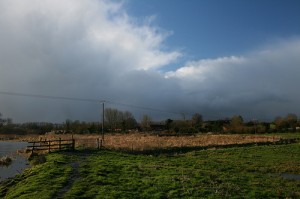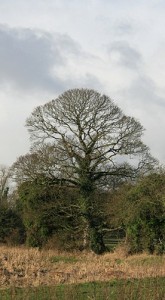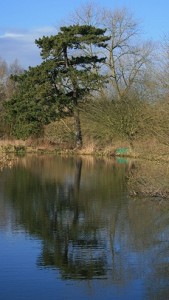The Roe doe watched us. She stood, focused and alert, roughly 20 yards out from the safety if Keeper’s Wood. Before she merged with the wood we could just about make out her shape – she was heavily in calf. As the light faded her grey brown colour allowed her to dissolve into the background.
-
Roe at Dusk
-
Slow Spring
Easter Monday. On the Town Field the plough is trailed by a long pennant of gulls. After days of cold easterly winds, the topsoil has at last dried out just enough to allow Spring cultivations to begin. The Church Field was first; cultivations started on Maundy Thursday and it was soon populated by feasting Lapwings and Gulls. Around the church a pair of Mistle Thrushes threaded their way across the dark soil. In places the furrows lay shining in wet slabs, elsewhere the loam crumbles into a rich tilth. In spite of the Spring sunshine, the temperatures stay too low to consider planting. David’s ewes munch their way through the dried rains of last season’s late growth and we all wait for the first flush of grass. But the Song Thrush declaims his territory with vigour and there is at least a promise that better weather is on the way.
-
Litter pick 2013
Late morning on Saturday, with snow in the air and a biting nor’easterly wind blowing, seven hardy souls ventured out to pick litter from around the village. The Big Tidy Up has become an annual event.
Fast food containers and the so-easily disposable coffee cups and endless beer bottles were there in usual quantities. A rather sad collection of empty bottles of a cheap whisky from some secret drinker near the railway line. The ever present wrappers from contractor’s packed lunches infested the routes through Hall Farm. The rather strange mentality that makes dog walkers bag up dog turd and then chuck the whole lot into the hedge baffles us. But, after completing various circuits of the byways around the village, all who turned out were satisfied with a job well done. Total litter harvest: 6 sacks full. Thanks to all who lent their time.
The crocuses are in flower around the village sign and this helps to lift the spirits.
-
Dawn in Mid-February
Dawn on a Sunday in mid-February arrived in a grey pall. A frost has etched its way through the garden and the air was still. But the sound of birdsong has gathered new strength; the Sing Thrush which has claimed an Ash tree to the west of the cottage was trading vocal blows with his rival neighbour at the Old Smithy. The dual followed strict rules. An opening five phrase repeat from one bird was followed by a pause and a response from the other. Their notes filled with the vigour and meaning as the serious business of territorial claims were reinforced. In the background Robins and Wrens added their own vocals. On the ground Snowdrops continue to flower and the early Daffodils venture forth with the yellow heralds trumpet.
-
Chill February wind – Winter prepares to leave
Sunday morning and a chill westerly wind cast a thin veil of ice on the puddles. After yesterday’s glimpses of sunshine the weather had reverted back to a gloomy chill-ridden morning. On the stubble field, alongside the railway line, a large flock of Fieldfares – perhaps a hundred strong – fled at our approach. Flying low and for a short distance they kept a respectable distance from us. Their ‘chuck-chuck’ calls revealing their nervousness. I wondered whether the flock size was a pre-migration gathering, but their leaving is probably some time off yet.
The wind whipped along the river Mermaid. A few Woodpigeon, curved their aerial path against the breeze. A Buzzard set its wings and soared just above tree height; a relaxed but string-less kite. Its rich rufous plumagewas illuminated in the thin morning light. After a short while, with a barely perceptible adjustment it alighted in the old ash tree. A Magpie landed nearby a mobbed the Buzzard from a branch a few yards away. Further on, another flock, this time Redwings, fled at our passing. The Winter, we feel, is slipping away.
-
Winter crowns

a sharp February hail storm heads south Hail from a passing squall stung our faces as we walked upstream from Oxnead. A reminder that we cannot take the arrival of the weak Spring sunshine for granted. As we pressed on the clouds moved southwards and the sun light broke through and created a dramatic contrast. Colour leaped from the highlighted trees and the shapes of their bare winter crowns gained new depth. Around the village
 the variety of trees gives texture to the landscape. a sycamore, so often
the variety of trees gives texture to the landscape. a sycamore, so often damned as a species, shows as a beautiful dome marking the edge of the ploughed lands and the start of the marsh. A Scots Pine sits over a gentle curve of the Bure, its reflection set with the pristine clarity of a Japanese print. Below the Hall Beech, Oak and the spiralling bark of the Chestnut provide an arboretum’s grandeur.
damned as a species, shows as a beautiful dome marking the edge of the ploughed lands and the start of the marsh. A Scots Pine sits over a gentle curve of the Bure, its reflection set with the pristine clarity of a Japanese print. Below the Hall Beech, Oak and the spiralling bark of the Chestnut provide an arboretum’s grandeur. -
Thaw and reflection
The weather softens after a fortnight of snow and frosts.But the hard spell that we have just experienced served to expose the variety of wildlife within the parish. Hunger and the serious business of courtship pushed dog fox and vixen into the daylight. The urban fox has become a common sight in Norwich, but the country fox is a a much more wary creature altogether. Their travels and territories are defined by river and railway line and the thaw releases the strong scent in many places. A sharp frosty starlit night is punctuated by their barks and screams as boundaries are set.
Elsewhere, Jenny reports whole families of hunting otter in the early morning light. On the arable fields the destructive power of foraging Roe Deer show up as snowy excavations. Teal spring out from out from under the reed fringed bank of the Bure and Grey Geese graze on the whatever passes for exposed vegetation on the Common. In the garden flocks of finches cluster in a frenzy of shuttle visits around the feeders. The wintering Little Egret manage to contrast in shades of white with the decaying snow.
A short burst of sunshine and the presence of Celandines, Snowdrops and the early shoots of Daffodils in the churchyard promise the approach of Spring. The colour green seems to suddenly return from the overnight thaw.
-
Looking forward in mid January
In mid January I am looking for change. Having ushered the new year in, I always feel it is time to look for those hints that Spring is not so far away. Last weekend the majestic wind blown song from an Oxnead Mistle Thrush sufficed.
Yesterday, the resonant drumming of a Great Spotted Woodpecker on a Brampton Hall Oak echoed along the Bure. It is a sound that I always connect with the emergence of Daffodils and the stirring of Primroses. Indeed, in the churchyard, the first leaves of some of the wild stock daffodils are inching above the sward. Even in that state they manage to lift away that winter feeling.
I nervously take a look at the beehives. Nervously, because they had a tough year in 2012 and there must always be question marks over the quality and quantity of their food reserves. I am encouraged that the clusters of each the colonies seem to be making the right noise as I tidy up around the hives. But there is a long way to go yet and the losses are often later in the winter or into the early spring, so we have sugar solution ready in reserve for that point in time.
-
White heron
A small white heron is a regular winter visitor to Brampton’s grazing meadows. The Little Egret used to be relatively uncommon in Norfolk and it’s visits in the 1960’s caused excitement in the bird watching fraternity. Now it seems to have suffer the curse of the commonplace – it is no longer rare enough to create the same level of excitement. However, it is a welcome guest to the water meadows here. It’s white plumage standing out in the Wintery greys and greens of the Meadows along the Mermaid river. The Egret’s yellow feet contrast strongly with it’s mainly black legs. It can be seen resting in a tall Ash tree or stealthily fishing in the river margins. Occasionally a second Egret appears on the scene. This usually signals the coming of Spring and the time to move back to the coast, perhaps to the breeding colony at Holkham.
-
Carol singing 2012
On Christmas Eve the Brampton Carol Singers abandoned their warm cottages in order to sing their way around the village. The choir of ten sang innumerable carols on their three hours tour and due to the generosity of villages raised a significant amount in favour of their chosen charity, Quidenham Children’s Hospice. In fact theory are still collecting and the final total will not be know for a while. Grateful thanks to all of you who were generous and hospitable during the evening. The evening ended with a short service at St Peter’s Church at which the now well-rehearsed Carols were given a further airing.
